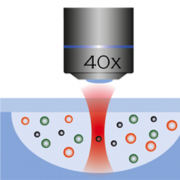Cells from different origins leave behind extracellular vesicles (EVs) in blood. Patients with cancer have tumour cells that do the same, but these tumour-derived extracellular vesicles (tdEVs) are vastly outnumbered by lipoproteins and EVs from other cells such as red blood cells, platelets and leukocytes. Researchers of the University of Twente and the University of Amsterdam managed to trap and accurately detect single tdEVs with a laser. The researchers present their results in the prestigious Journal of Extracellular Vesicles.
DETECTING WITHOUT LABELS
In cancer diagnostics, extracellular vesicles attract a lot of attention. The nano-sized particles are naturally released from all types of cells. When you detect tumour-derived extracellular vesicles in a patient’s blood, they can inform you about the effectiveness of a cancer treatment. The problem is that the number of tdEVs in a patient’s blood is extremely small, compared to lipoproteins and other ‘normal’ EVs. “Distinguishing tdEVs from other particles in plasma is challenging even with labels such as antibodies, which are not specific enough and can clump together and create a false tdEV”, says UT researcher Agustin Enciso-Martinez. His method can detect tdEVs with an accuracy of over 95 percent in a label-free manner.
この情報へのアクセスはメンバーに限定されています。ログインしてください。メンバー登録は下記リンクをクリックしてください。

